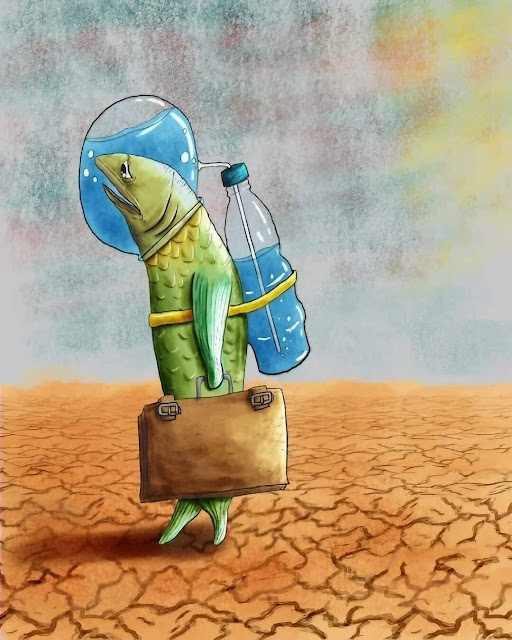Photosynthesis is one of the most fundamental and
awe-inspiring processes in the natural world. It is the driving force behind
the growth of plants, the oxygen we breathe, and the sustenance of nearly all
life on Earth. In this article, we will delve into the fascinating world of
photosynthesis, exploring its mechanisms, significance, and the remarkable
impact it has on our planet.
Understanding Photosynthesis
Photosynthesis is the process by which green plants, algae,
and some bacteria convert sunlight, carbon dioxide (CO2), and water into
glucose (a type of sugar) and oxygen (O2). This extraordinary transformation
takes place within the chloroplasts, the tiny green structures in plant cells
responsible for trapping sunlight.
The overall chemical equation for photosynthesis can be
summarized as follows:
6 CO2 + 6 H2O + sunlight → C6H12O6
(glucose) + 6 O2
In essence, photosynthesis uses the energy from sunlight to
synthesize glucose and release oxygen as a byproduct. This process can be
broken down into two main stages: the light-dependent reactions and the
light-independent reactions (also known as the Calvin cycle).
Light-Dependent Reactions
The first stage of photosynthesis, the light-dependent
reactions, occurs in the thylakoid membrane of the chloroplasts. Here, sunlight
is absorbed by chlorophyll, a green pigment, and converted into chemical
energy. This energy is used to split water molecules into oxygen and protons,
releasing oxygen as a waste product. Simultaneously, it generates energy-rich
molecules, such as ATP (adenosine triphosphate) and NADPH (nicotinamide adenine
dinucleotide phosphate), which are crucial for the next stage of
photosynthesis.
Calvin Cycle
(Light-Independent Reactions)
The Calvin cycle, the second stage of photosynthesis, takes
place in the stroma of chloroplasts. In this stage, the ATP and NADPH generated
during the light-dependent reactions are used to convert carbon dioxide into
glucose. This process involves a series of enzymatic reactions and ultimately
results in the creation of glucose, which can be used by the plant for energy
or stored for later use.
The Significance of
Photosynthesis
Photosynthesis is a cornerstone of life on Earth for several
reasons:
Oxygen Production:
Photosynthesis is responsible for producing a significant portion of the oxygen
in the Earth's atmosphere. Without photosynthesis, the levels of atmospheric
oxygen would decrease dramatically, making it difficult for most aerobic
organisms, including humans, to survive.
Carbon Dioxide Reduction:
By absorbing and converting carbon dioxide into glucose, photosynthesis helps
regulate the Earth's carbon cycle. This plays a vital role in mitigating the
greenhouse effect and stabilizing global climate conditions.
Energy Source:
Photosynthesis provides energy in the form of glucose. This energy source fuels
plant growth, which, in turn, supports herbivores and omnivores in the food
chain. Ultimately, photosynthesis is the foundation of all terrestrial food
webs.
Biological Diversity:
Photosynthetic organisms, such as plants, algae, and some bacteria, form the
base of many ecosystems. Their presence and ability to convert sunlight into
food create diverse habitats that sustain countless species.
Sustainability: As
the world grapples with environmental challenges and the need for sustainable
practices, understanding photosynthesis and harnessing its principles could
hold the key to developing renewable energy sources and mitigating climate
change.
The Future of Photosynthesis
While photosynthesis has been a natural process for billions
of years, scientists are continually researching ways to enhance its efficiency
and adapt it for various applications. Some of these applications include:
Crop Improvement: Scientists are working to enhance the
photosynthetic efficiency of crop plants to increase agricultural yields and
help meet the growing global food demand.
Biofuel Production:
Researchers are exploring ways to use photosynthetic organisms to produce
biofuels as an environmentally friendly alternative to fossil fuels.
Carbon Capture:
The concept of "artificial photosynthesis" involves creating systems
that mimic natural photosynthesis to capture and store carbon dioxide from the
atmosphere, potentially helping combat climate change.
In conclusion, photosynthesis is a remarkable process that
sustains life on Earth as we know it. It not only provides the oxygen we
breathe and the food we eat but also has far-reaching implications for
addressing global challenges such as climate change and food security.
Understanding and harnessing the power of photosynthesis is a key to a more
sustainable and prosperous future for our planet.









.png)























